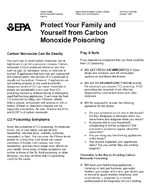Carbon Monoxide's Impact on Indoor Air Quality

Available in these languages:
Never use a portable generator inside homes, garages, crawlspaces, sheds or similar areas. Deadly levels of carbon monoxide can quickly build up in these areas and can linger for hours, even after the generator has shut off.
On this page:
- Overview
- Sources of Carbon Monoxide
- Health Effects Associated with Carbon Monoxide
- Levels in Homes
- Steps to Reduce Exposure to Carbon Monoxide
- Measurement Methods
- Exposure Limits
- Links to Additional Information
- About Carbon Monoxide Alarms
- Portable Generators
- Publications
On other pages:
- Protect Your Family and Yourself from Carbon Monoxide Poisoning
- Factsheet - Carbon Monoxide Poisoning: Protect Your Family and Yourself
- Infographic - Carbon Monoxide Alarms: Protect Your Family and Yourself
Overview
Carbon monoxide is an odorless, colorless and toxic gas. Because it is impossible to see, taste or smell the toxic fumes, CO can kill you before you are aware it is in your home. The effects of CO exposure can vary greatly from person to person depending on age, overall health and the concentration and length of exposure.
Sources of Carbon Monoxide
Sources of CO include:
- unvented kerosene and gas space heaters
- leaking chimneys and furnaces
- back-drafting from furnaces, gas water heaters, wood stoves and fireplaces
- gas stoves
- generators and other gasoline powered equipment
- automobile exhaust from attached garages
- tobacco smoke
- auto, truck, or bus exhaust from attached garages, nearby roads, or parking areas
- incomplete oxidation during combustion in gas ranges, and unvented gas or kerosene heaters
- worn or poorly adjusted and maintained combustion devices (e.g., boilers, furnaces)
- if the flue is improperly sized, blocked or disconnected
- if the flue is leaking
Health Effects Associated with Carbon Monoxide
At low concentrations:
- fatigue in healthy people
- chest pain in people with heart disease
At moderate concentrations:
- angina
- impaired vision
- reduced brain function
At higher concentrations:
- impaired vision and coordination
- headaches
- dizziness
- confusion
- nausea
- flu-like symptoms that clear up after leaving home
- fatal at very high concentrations
Acute effects are due to the formation of carboxyhemoglobin in the blood, which inhibits oxygen intake.
At low concentrations, fatigue in healthy people and chest pain in people with heart disease. At higher concentrations, impaired vision and coordination; headaches; dizziness; confusion; nausea. Can cause flu-like symptoms that clear up after leaving home. Fatal at very high concentrations. Acute effects are due to the formation of carboxyhemoglobin in the blood, which inhibits oxygen intake. At moderate concentrations, angina, impaired vision, and reduced brain function may result. At higher concentrations, CO exposure can be fatal.
Levels in Homes
Average levels in homes without gas stoves vary from 0.5 to 5 parts per million (ppm). Levels near properly adjusted gas stoves are often 5 to 15 ppm and those near poorly adjusted stoves may be 30 ppm or higher.
Steps to Reduce Exposure to Carbon Monoxide
It is most important to be sure combustion equipment is maintained and properly adjusted. Vehicular use should be carefully managed adjacent to buildings and in vocational programs. Additional ventilation can be used as a temporary measure when high levels of CO are expected for short periods of time.
- Keep gas appliances properly adjusted.
- Consider purchasing a vented space heater when replacing an unvented one.
- Use proper fuel in kerosene space heaters.
- Install and use an exhaust fan vented to outdoors over gas stoves.
- Open flues when fireplaces are in use.
- Choose properly sized wood stoves that are certified to meet EPA emission standards. Make certain that doors on all wood stoves fit tightly.
- Have a trained professional inspect, clean and tune-up central heating system (furnaces, flues and chimneys) annually.
- Repair any leaks promptly.
- Do not idle the car inside garage.
Measurement Methods
Some relatively high-cost infrared radiation adsorption and electrochemical instruments do exist. Moderately priced real-time measuring devices are also available. A passive monitor is currently under development.
Exposure Limits
Occupational Safety and Health Guideline for Carbon Monoxide (pdf)
* OSHA Note: This guideline summarizes pertinent information about carbon monoxide for workers and employers as well as for physicians, industrial hygienists, and other occupational safety and health professionals who may need such information to conduct effective occupational safety and health programs. Recommendations may be superseded by new developments in these fields; readers are therefore advised to regard these recommendations as general guidelines and to determine whether new information is available.
[OSHA PEL] The current Occupational Safety and Health Administration (OSHA) permissible exposure limit (PEL) for carbon monoxide is 50 parts per million (ppm) parts of air (55 milligrams per cubic meter (mg/m(3))) as an 8-hour time-weighted average (TWA) concentration [29 CFR Table Z-1].
[NIOSH REL] The National Institute for Occupational Safety and Health (NIOSH) has established a recommended exposure limit (REL) for carbon monoxide of 35 ppm (40 mg/m(3)) as an 8-hour TWA and 200 ppm (229 mg/m(3)) as a ceiling [NIOSH 1992]. The NIOSH limit is based on the risk of cardiovascular effects.
[ACGIH TLV] The American Conference of Governmental Industrial Hygienists (ACGIH) has assigned carbon monoxide a threshold limit value (TLV) of 25 ppm (29 mg/m(3)) as a TWA for a normal 8-hour workday and a 40-hour workweek [ACGIH 1994, p. 15]. The ACGIH limit is based on the risk of elevated carboxyhemoglobin levels [ACGIH 1991, p. 229].
Links to Additional Information
EPA
- EPA's Office of Aging: Fact sheet: Carbon Monoxide Poisoning Prevention (pdf) January 2009.
Centers for Disease Control and Prevention (CDC), National Center for Environmental Health
- Carbon Monoxide Poisoning Fact Sheet (offered in many languages)
U.S. Department of Homeland Security
16825 S. Seton Avenue,
Emmitsburg, MD 21727
Voice: (301) 447-1000
Fax: (301) 447-1346
Admissions Fax: (301) 447-1441
Occupational Safety and Health Administration (OSHA)
- Fact Sheet on Carbon Monoxide (pdf) (549 KB)
U.S. National Library of Medicine and the National Institute of Health
Consumer Products Safety Commission (CPSC)
- Consider Products Safety Commission for safe generator use and product recalls
- CPSC's Hotline: 1-800-638-2772
- SaferProducts.gov where you can report incidents involving carbon monoxide and/or consumer products to CPSC.
About Carbon Monoxide Alarms
- Centers for Disease Control and Prevention (CDC) "Carbon Monoxide (CO) Poisoning Prevention"
- CPSC Recommends Carbon Monoxide Alarms for Every Home. The U.S. Consumer Product Safety Commission (CPSC) recommends that every home have carbon monoxide (CO) alarms on each level outside each sleeping area. In addition, CPSC urges consumers to have an annual professional inspection of all fuel- burning appliances -- including furnaces, stoves, fireplaces, clothes dryers, water heaters, and space heaters -- to detect deadly carbon monoxide leaks.
- Underwriters' Laboratory Carbon Monoxide Safety
Portable Generators
Consumer Product Safety Commission (CPSC): Portable generators are useful when temporary or remote electric power is needed, but they also can be hazardous. A generator's exhaust contains carbon monoxide. This is a poison you cannot see or smell. Never use a generator inside a home or garage, even if doors and windows are open. Only use generators outside and far away from windows, doors and vents.
- Portable Generator Hazards
- What to Know: Generators and CO (CPSC #468)
- Alert!! Preventing Carbon Monoxide Poisoning from Small Gasoline-Powered Engines and Tools. (1996)
- This joint alert from NIOSH, CDPHE, CPSC, OSHA and EPA warns that people using gasoline-powered tools such as high-pressure washers, concrete cutting saws (walk-behind/hand-held), power trowels, floor buffers, welders, pumps, compressors, and generators in buildings or semi-enclosed spaces have been poisoned by Carbon Monoxide. Recommendations for preventing CO poisoning are provided for employers, equipment users, tool rental agencies, and tool manufacturers.
Single copies of the Alert [DHHS (NIOSH) Publication No. 96-118] are available for free from: Publication Dissemination, IED, National Institute for Occupational Safety and Health; Cincinnati, OH, fax number: (513) 533-8573, phone number: 1-800-35-NIOSH (1-800-356-4674), email: pubstaft@niosdt1.em.cdc.gov
- This joint alert from NIOSH, CDPHE, CPSC, OSHA and EPA warns that people using gasoline-powered tools such as high-pressure washers, concrete cutting saws (walk-behind/hand-held), power trowels, floor buffers, welders, pumps, compressors, and generators in buildings or semi-enclosed spaces have been poisoned by Carbon Monoxide. Recommendations for preventing CO poisoning are provided for employers, equipment users, tool rental agencies, and tool manufacturers.
Publications
EPA Publications

- Carbon Monoxide and the Nervous System. Raub, J. A., and V. A. Benignus. Carbon Monoxide and the Nervous System. Neuroscience and Behavioral Reviews 26(8):925-940, (2002).
- Carbon Monoxide Poisoning - A Public Health Perspective. Raub, J. A., M. Mathieunolf, N. B. Hampson, and S. R. Thom. Carbon Monoxide Poisoning - a Public Health Perspective. TOXICOLOGY (145):1-14, (2000).
- Revised Evaluation of Health Effects Associated With Carbon Monoxide Exposure: An Addendum to the 1979 EPA Air Quality Criteria Document for Carbon Monoxide Benignus, V., L. Grant, D. Mckee, and J. Raub. Revised Evaluation of Health Effects Associated With Carbon Monoxide Exposure: An Addendum to the 1979 EPA Air Quality Criteria Document for Carbon Monoxide. U.S. Environmental Protection Agency, Washington, D.C., EPA/600/8-83/033F (NTIS PB85103471).
- Protect Your Family and Yourself from Carbon Monoxide Poisoning
- Discusses health hazards associated with exposure to carbon monoxide (CO), a colorless, odorless gas which can cause headaches, dizziness, nausea, faintness, and, at high levels, death. Provides guidance on what to do if you think you are suffering from CO poisoning and what to do to prevent exposure to CO. Also included is a brief discussion about carbon monoxide detectors. EPA-402-F-96-005, October 1996
- The Carbon Monoxide fact sheet has also been translated into Vietnamese EPA 402-F-99-004C, Chinese EPA 402-F-99-004A and Korean EPA 402-F-99-004B
Consumer Product Safety Commission Publications
- Read CPSC publications about carbon monoxide.
- Carbon Monoxide Questions and Answers (CPSC publication #466)
